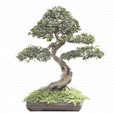
The main characteristics to look for when selecting bonsai material are health, hardiness and lack of disease and pests. The most practical tree size to start out with is one in a one- to five-gallon container. If you are just starting out, keep in mind the hardiness; if a species is high-maintenance are you prepared to do the extra work to keep it trained and even more important - alive? The tree should be attractive to you - an important factor as your imagination forms the design your tree will soon take. Also consider the following:
Trunk
The tree should have a well-shaped trunck, tapering gradually toward the top and having nice bark.
Branches
If the tree has not yet begun its training, it should have plenty of branches growing in all directions from the trunk. The lower branches should be strong and healthy.
Roots
Check under the surface of the soil and feel for well-distributed main roots, which should spread in all directions.
Leaves
If deciduous, the tree should have small leaves. If a conifer (evergreen), the needle size is not important at this time.
Species
The species of tree should be fairly fast-growing and do well in your area. The best results com from boxwood, buttonwood, crepe myrtle, cypress, elm, ficus, Fukien tea, jaboticaba, juniper, podocarpus, pyracantha Surinam cherry or other tree with small leaves or short needles. Click here for a photo of a variety of stock plants of these species.
What to avoid
- Lanky, sparsely branched trees
- Trees that are too tall. Most styles do well with a tree proportioned like a CHristmas tree, or which squats lower like a wide pyramid.
- Trees with long branches and no foliage close to the trunk.
- Branches that start too far up the trunk.
- Trees not suited for bonsai: African tulip. coconut, monkeypod, Norfolk Island or Cook Island pines, plumeria and ti.
Page last updated: November 30, 2008 | Privacy Policy | Terms of Use